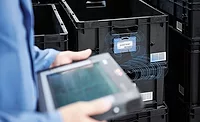4 Key Questions for Food and Beverage Digital Transformation

Photo by freestocks on Unsplash
Digital transformation isn’t a new idea in the business world, but the work required to bring it about in food and beverage production companies is no simple task. Just about every operational leader I talk to says they’re feeling pressure to accelerate digital transformation, increase investment in digital tools and move toward more data-driven, analytics-powered decision making.
Now, they’re looking at economic volatility that’s adding urgency to drive efficiency and create competitive advantages through tech-enabled strategies. But that economic uncertainty is also increasing pressure to get it right. They can’t afford to spend on failed tech transformation like the estimated 70% of digital transformation initiatives that McKinsey says ultimately fail.
With every vendor pushing “digital” solutions in various states of maturity, perhaps the biggest challenge is choosing digital tools that align with the business’ key challenges and objectives.
Here are four key questions to help food and beverage manufacturers get the most out of their digital transformation efforts:
How can I use technology to address labor scarcity?
According to the U.S. Bureau of Labor Statistics, there were more than 9.6 million job openings that were unfilled in the U.S. as of June 2023—while only 5.8 million people were considered “out of work.” In other words, even if every available worker accepted a job, there will still be millions of unfilled positions.
Despite rounding the corner of the COVID-19 pandemic that spurred this dilemma, the labor shortage is the industry’s new normal that is expected to only worsen over time. Digital transformation has the potential to offset labor scarcity and support a shifting workspace. Food and beverage manufacturers need to rethink how work gets done and embrace technology to offset labor shortages.
Technology can also modernize processes reliant on ad hoc reports and outdated systems such as using spreadsheets and other simple databases to view production data. With fewer employees to flag and remediate potential problems, digital technology can pick up the slack by automatically benchmarking performance, illustrating KPIs and surfacing the insights that matter most. Digital transformation has the power to help food and beverage operations better protect quality and ensure safety—while driving greater profitability.
Do I need to employ technology to simplify compliance?
The short answer is “yes.” Since the 2011 Food Safety Modernization Act (FSMA) became law, food and beverage manufacturers have been asked to embrace completely new and ever-evolving standards and practices. For example, manufacturers are now tasked with taking proactive steps to prevent foodborne illness, rather than reacting when illness occurs among the public.
Investment in digital technologies will be key to meeting these requirements without putting an immense strain on existing operations. Technology that can support these regulation challenges will need to be dialed in to the specific data and reports food and beverage manufacturers need. The technology platform selected should be designed to consider FSMA data collection requirements and offer built-in data collection, analysis and reporting features so that manufacturers can streamline compliance reporting.
How do I ensure my operations get actionable insights—not just data?
No doubt, there’s a massive amount of data flowing through food and beverage operations every day. Unraveling complexity and unlocking the full value of data might seem like a daunting task. Yet, there are powerful digital analytics tools that can find the meaningful, actionable signal in the “noise.”
Digital analytics tools don’t replace humans. They work alongside humans to provide the best of digital processing power so humans can make decisions driven by relevant, useful information. But there are a variety of analytics tools available, so finding the right one is important.
Look for a truly purpose-built platform for food and beverage data processing that reveals how the data and analytics insights will impact the business. An ideal analytics tools will provide automated alerts and a dashboard that easily displays key metrics. Look for an analytics tool that also has a benchmarking feature so you can drill into the data by plant, shift, line and industry standards.
What do I look for to make sure a technology will be scalable?
Automation, digitization and evolving regulations are changing the food and beverage processing world faster than ever. That’s why food and beverage processors need to ensure that their tech investments are truly future-ready.
Look for a technology platform that can easily adapt to requirement and workflow changes and a technology provider that continually adapts and evolves to stay ahead of changes. To learn if a provider is dedicated to creating technology aligned with the industry’s changing needs and requirements, ask about the design principles that drove the technology in its inception and how the provider plans to invest in and expand the platform going forward. A platform focused on the food and beverage industry is more likely to incorporate customer requests and suggestions into future innovation plans.
Digital Transformation is a Lifeline
“Going digital” isn’t just for the forerunners anymore—it’s a necessary shift to keep up with competitors who are already building tech-enabled advantages. It’s the most efficient way to meet regulators’ increasingly data-driven requirements. And it will be key to capturing the vast institutional knowledge that threatens to walk out the door as baby boomers retire.
As much as food and beverage companies stand to gain from digital transformation, they also stand to lose big if their tech investments fail to deliver on promised value. With these high stakes, wading into the proliferating pool of digital food and beverage solutions is no doubt daunting. But to keep your investments on track, you need tools that specifically align with your primary challenges. And to smooth the path to realizing that value, you need those tools to be purpose-built for the complexities of food and beverage production—so you can hit the ground running.
Looking for a reprint of this article?
From high-res PDFs to custom plaques, order your copy today!







